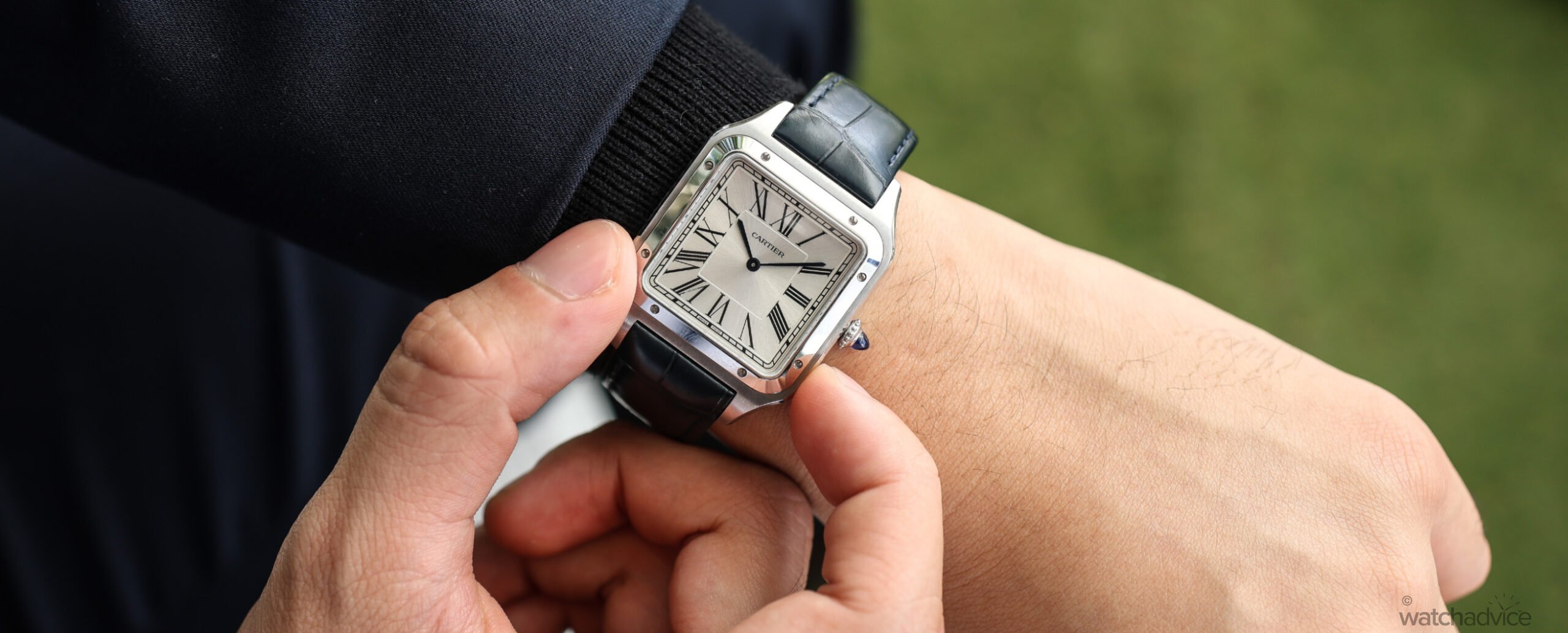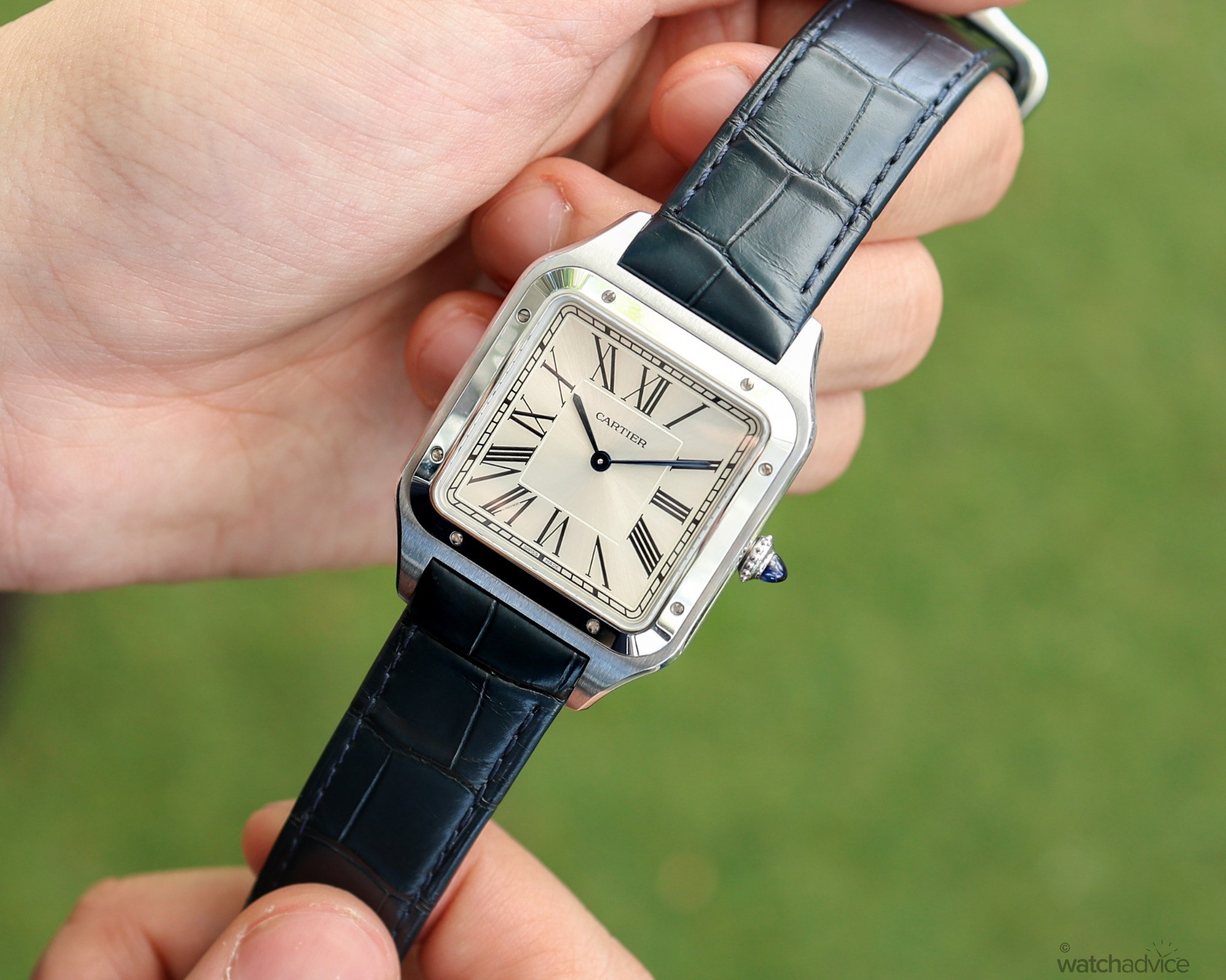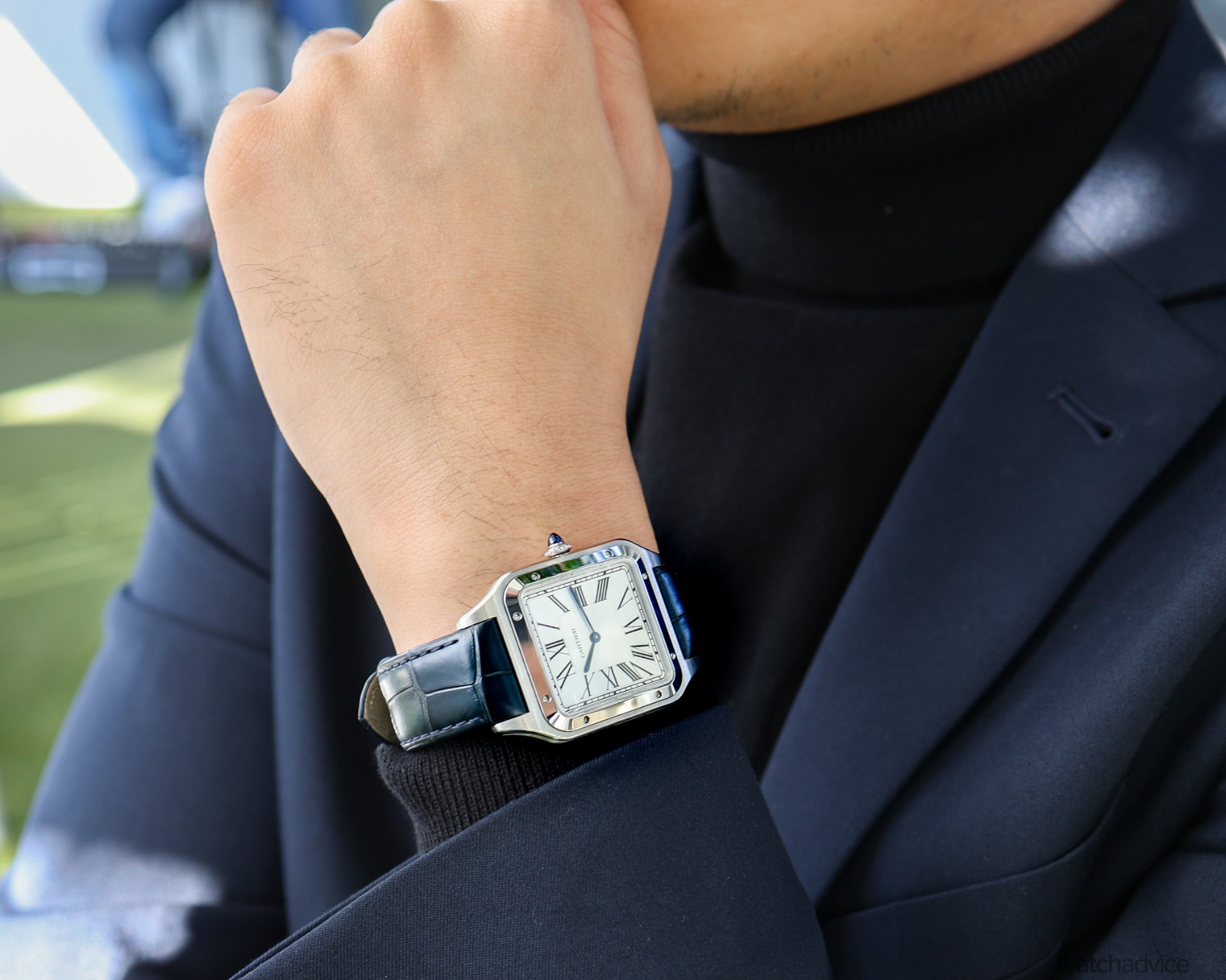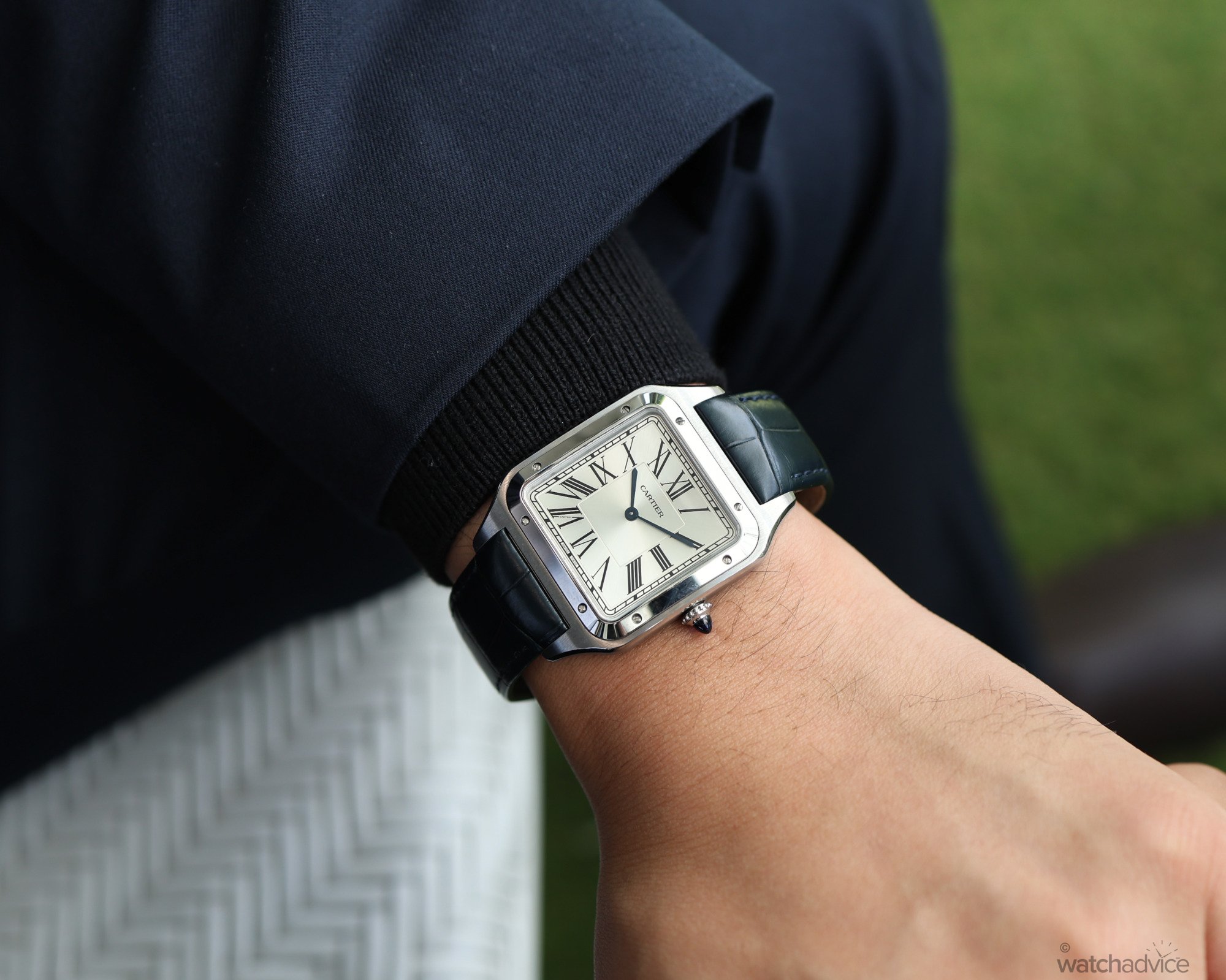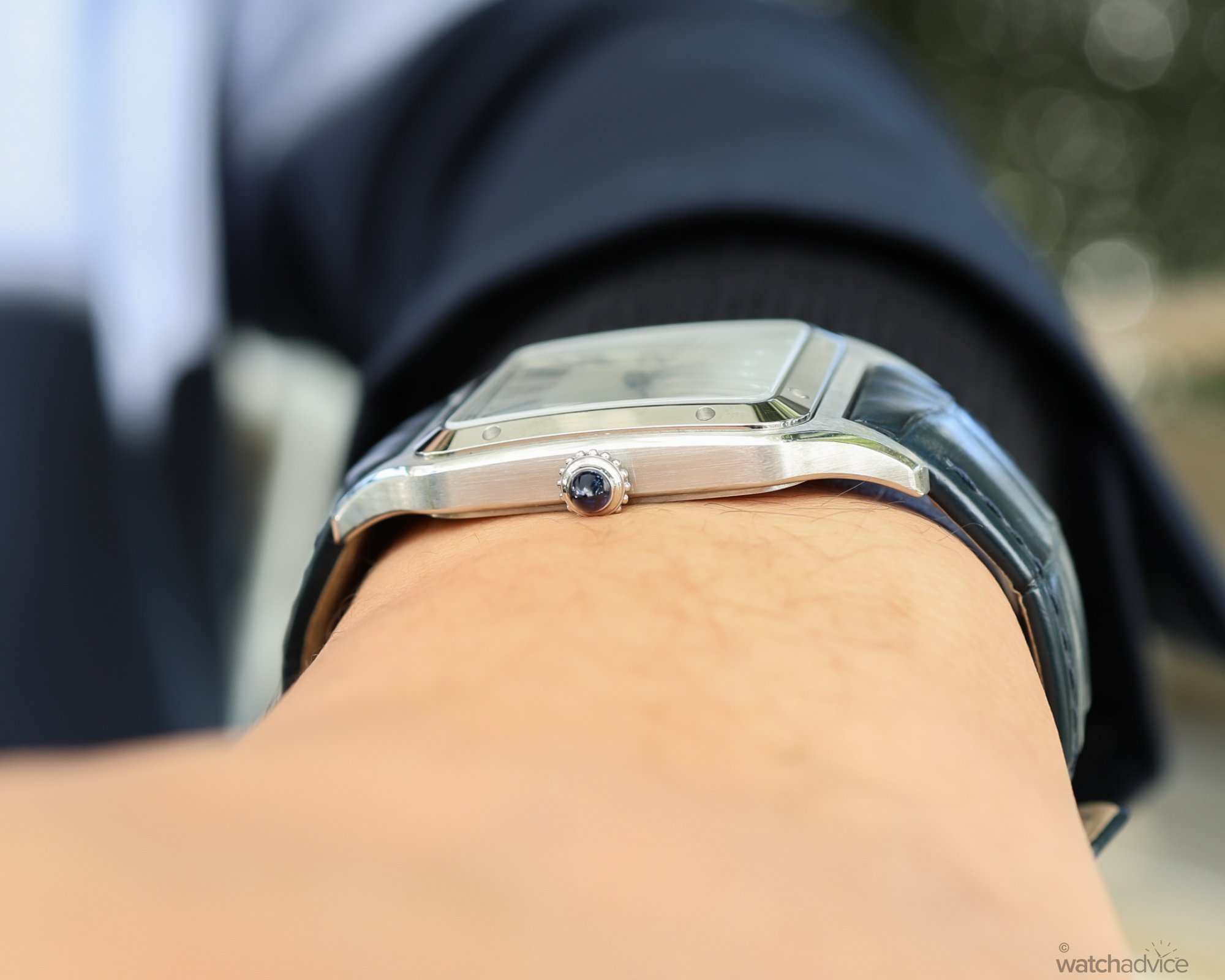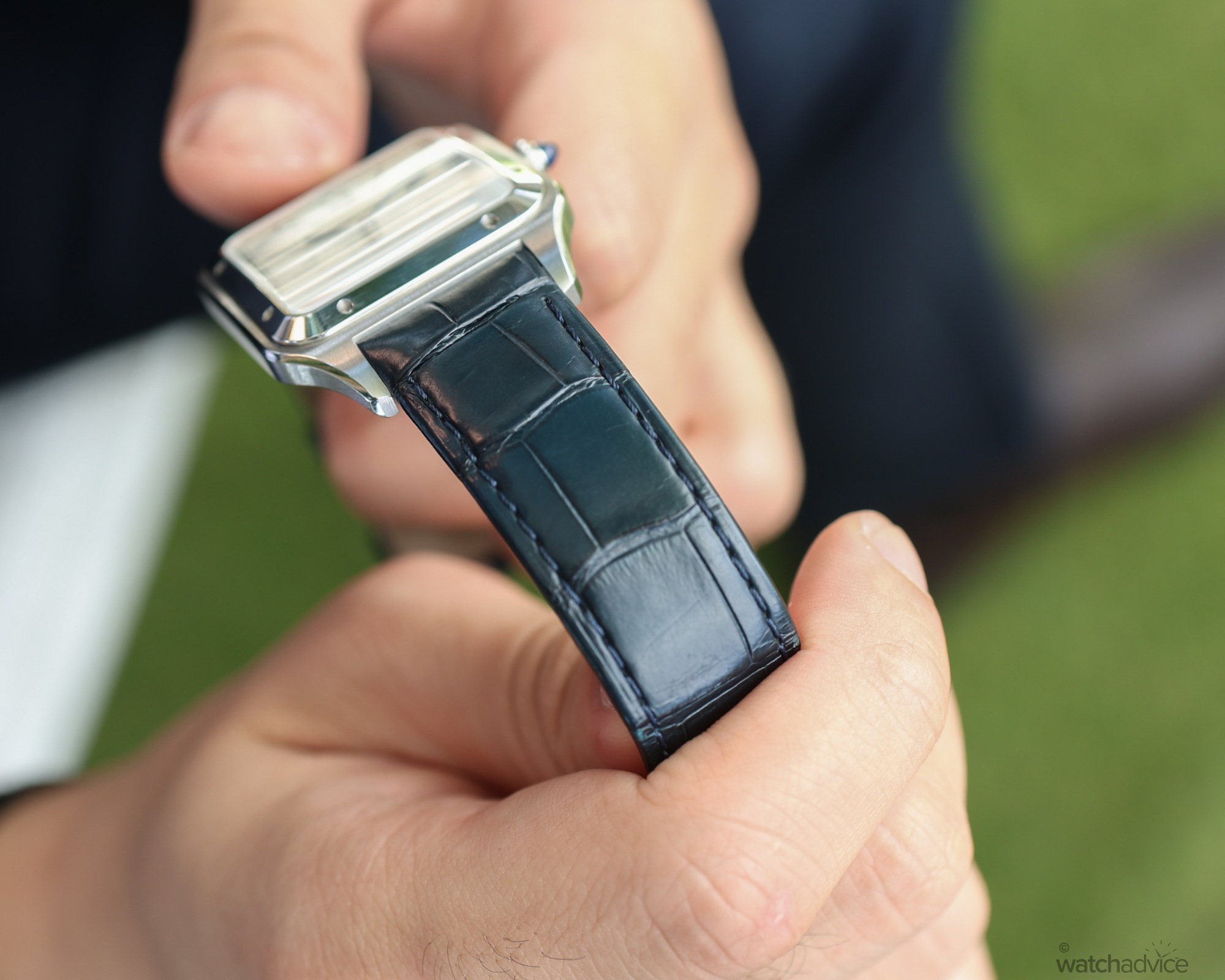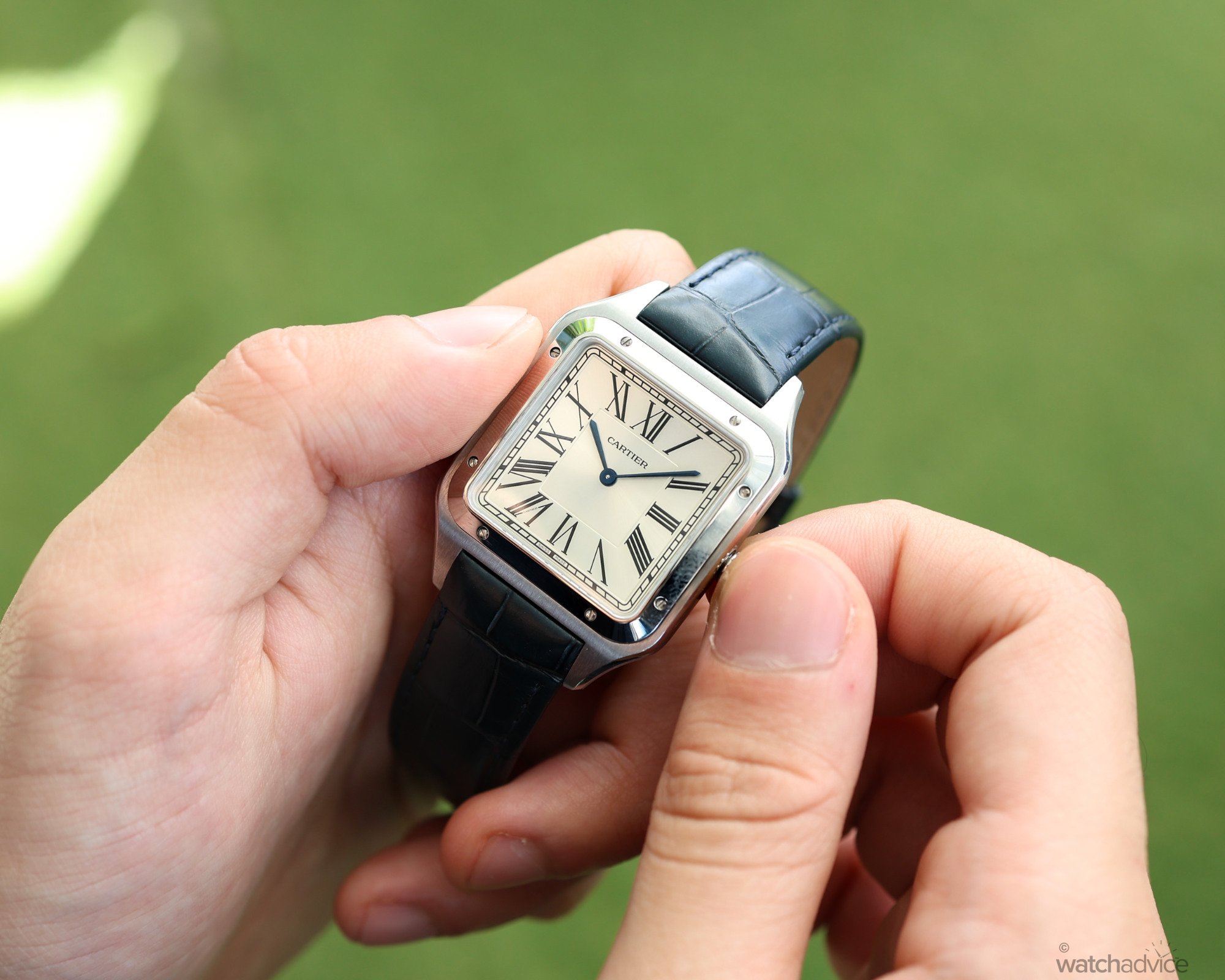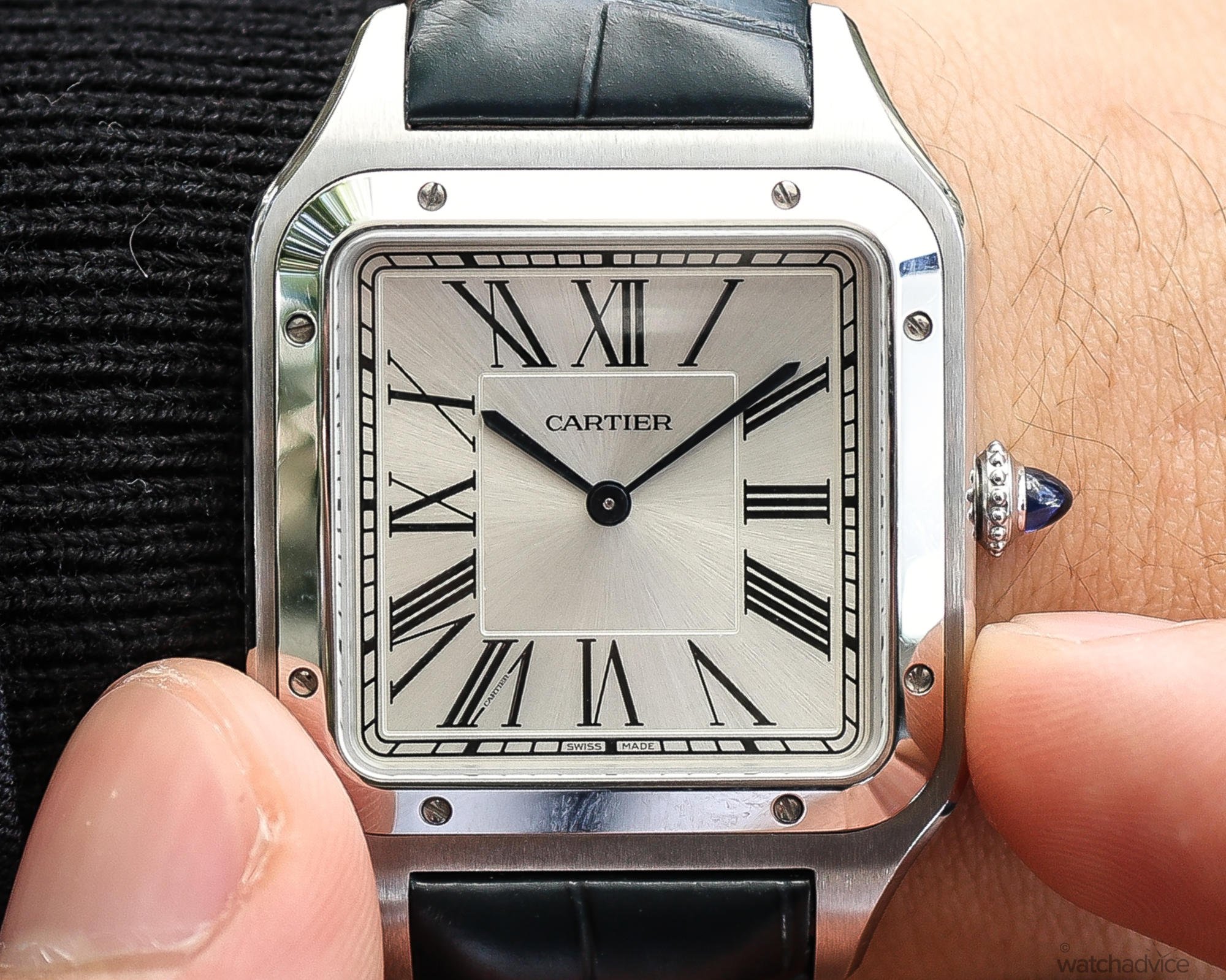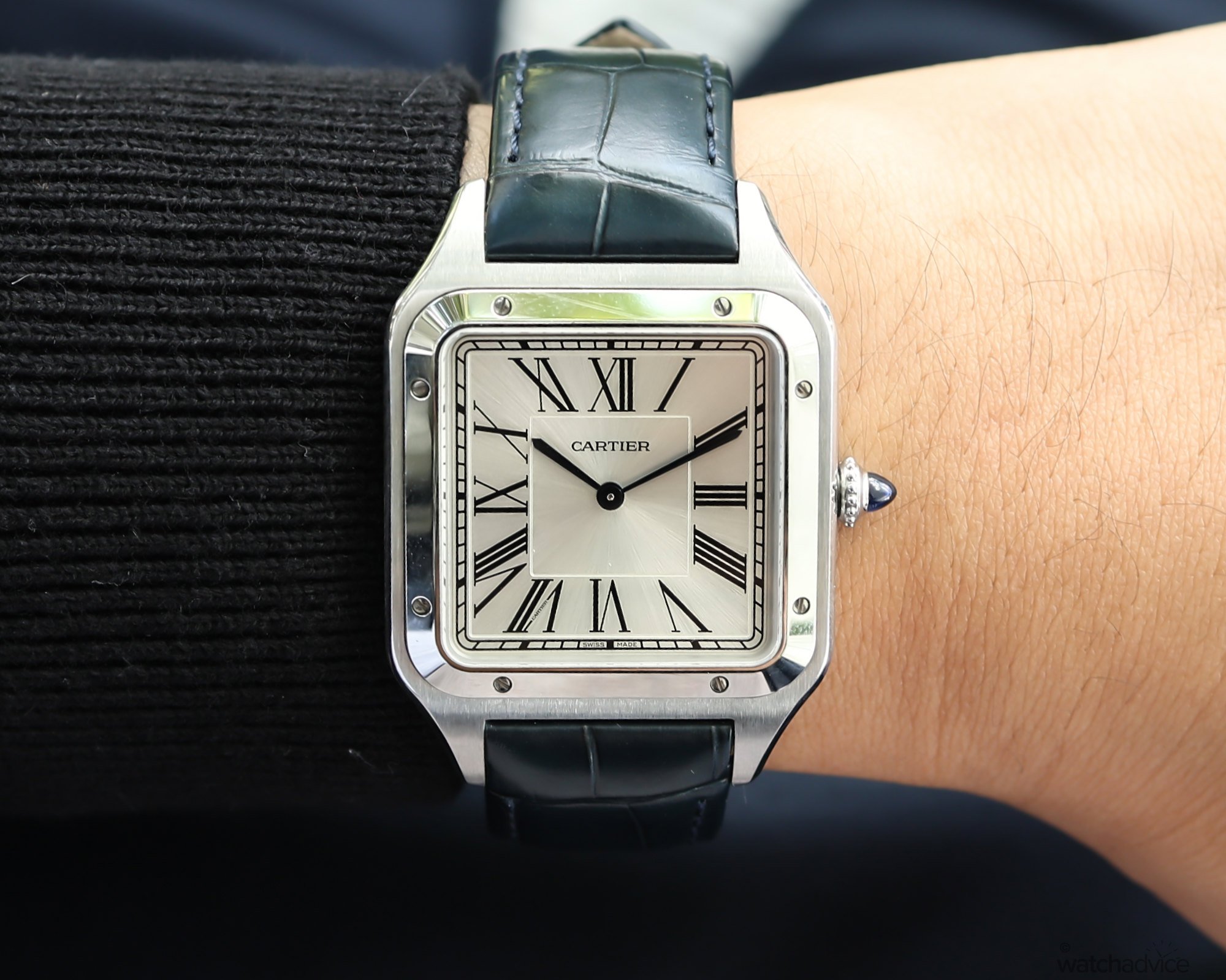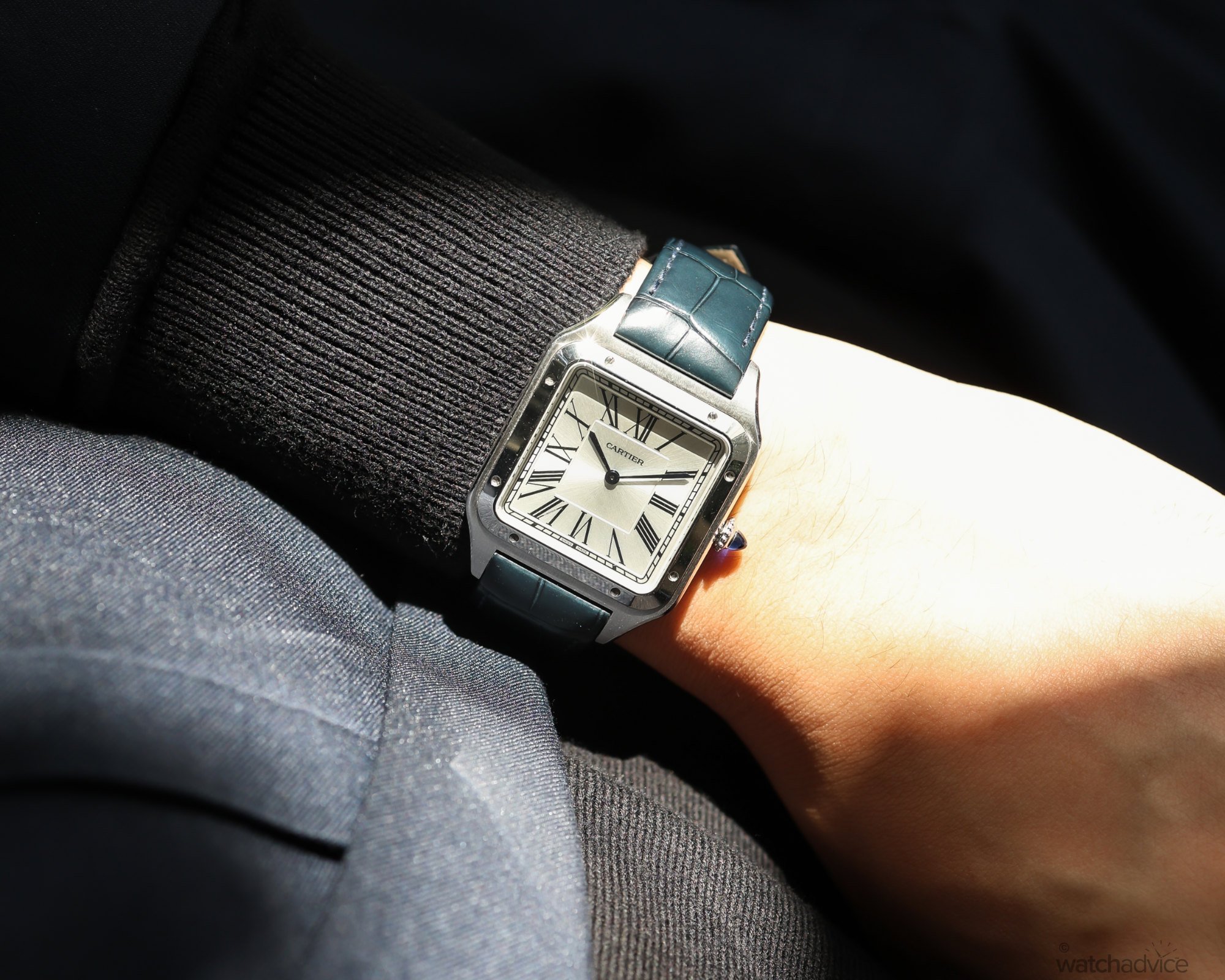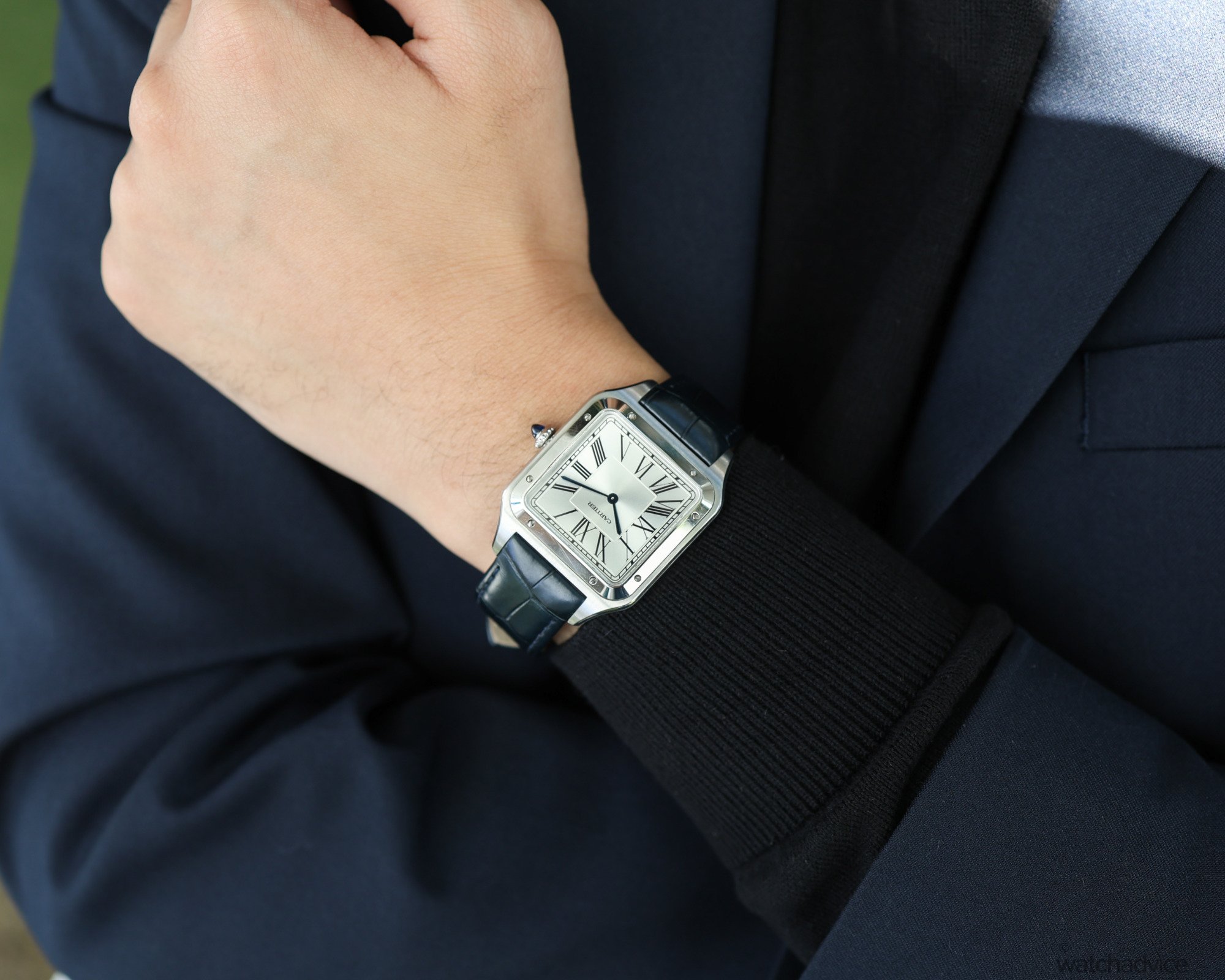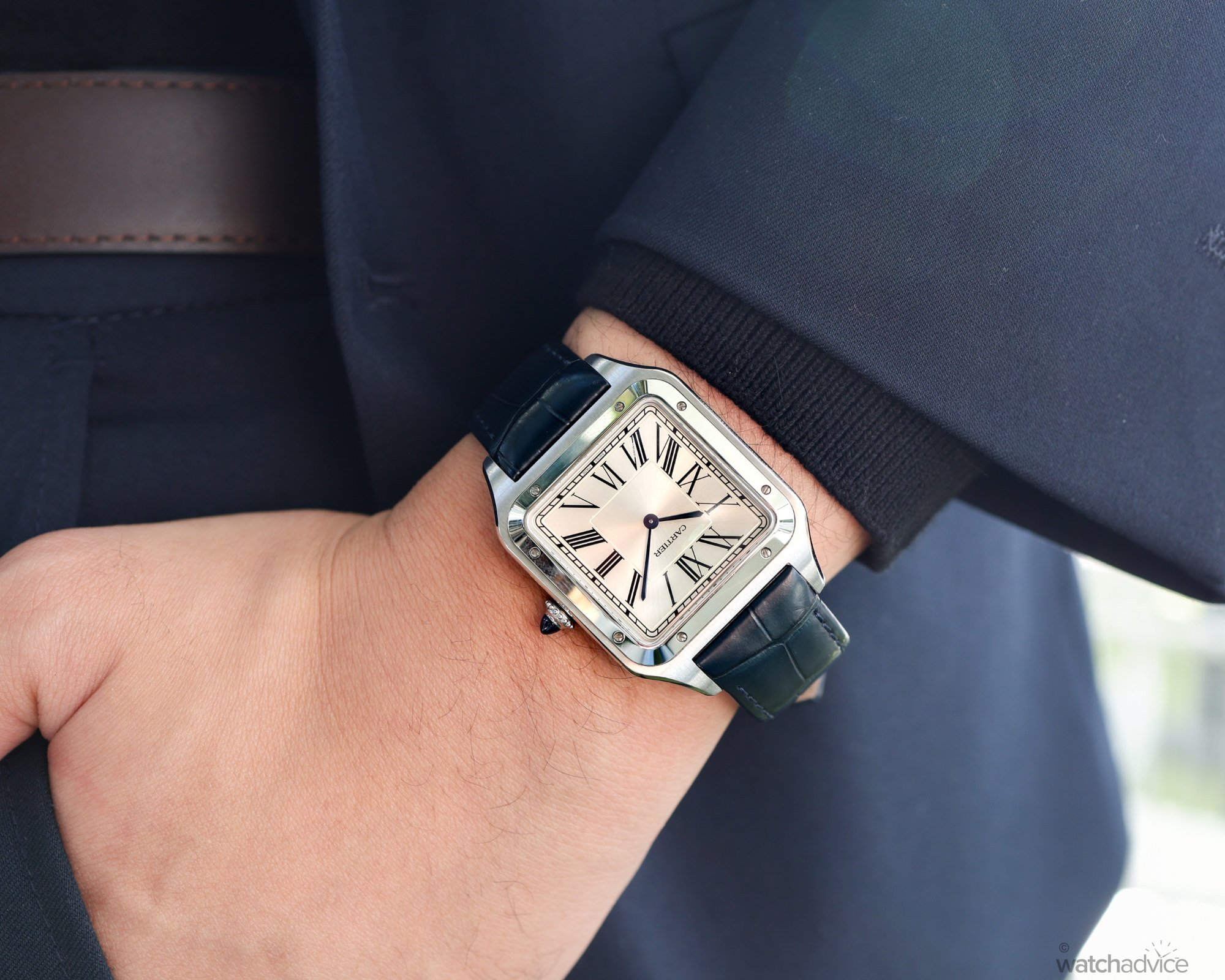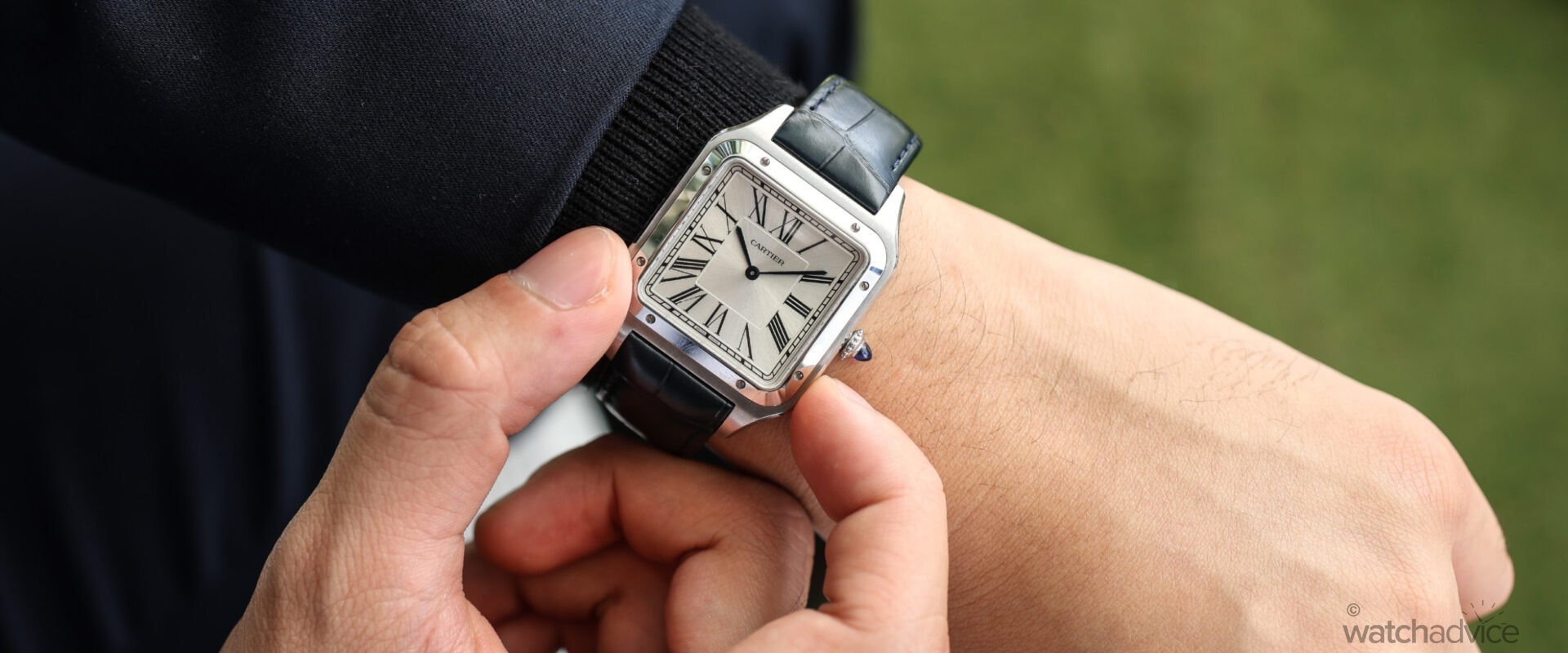The Cartier Santos Dumont is a watch beautifully frozen in time – aesthetically and functionally true to the original, and it’s still as relevant as ever in 2024.
What We Love
- Classic and timeless design
- Thin, elegant, and comfortable on the wrist
- Movement is smooth and appropriate for a dress piece
What We Don’t
- Wears larger than anticipated (due to my small wrists)
- The pin buckle is finicky at times and hard to adjust
- A display case back would be great!
Overall Rating: 8.5/10
- Value for Money: 8/10
- Wearability: 8/10
- Design: 9/10
- Build Quality: 9/10
Ah, Cartier: One of the pillars of modern watchmaking as we know it. Even though they are a High Jewellery Maison, their knowledge of horology is storied and epic, and through their achievements, sparked some of the most important innovations in the history of this beautiful art.
I’ve known about Cartier and their reputation my whole life, but other than occasionally peering into their boutique and looking through the window, I always thought my opinion of them would never extend further than their occasional appearances in rom-coms, music, and other pop culture.
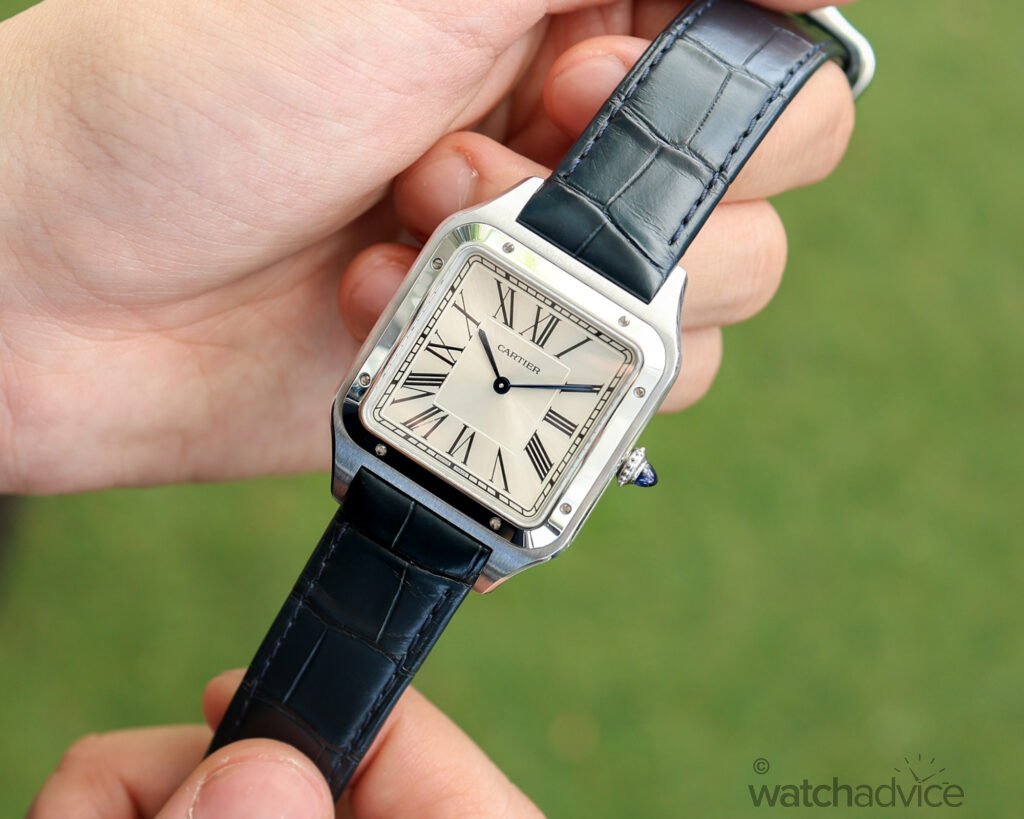
Getting into the watch business gave me a whole new perspective on what I knew about the Parisian brand. Getting into Watch Advice also allowed me to take a massive deep dive into Cartier’s history, which naturally garnered a new respect for them. The Santos was the first ever wristwatch? How crazy is that?
I won’t nerd you out with the details, as I already wrote an article briefly touching on the history of said wristwatch, but you can imagine that I was already chomping at the bit to get my hands on one to review. When the opportunity came, of course I was going to take it!
RELATED READING: The Santos Stories – A Brief History Of An Icon
First Impressions
Initially re-released in 2019/2020, the Cartier Santos Dumont stands out in the Santos collection. If you’re unfamiliar with the history of Cartier, you’d be puzzled to find that, among the more robust Santos de Cartier lineup, there lies a slim, delicate, and dresser watch bearing a similar name. Don’t worry if you were a little confused – I sure was.
But, the Santos Dumont isn’t just Cartier trying to capitalise on a dress watch market. In fact, it’s quite the opposite: It’s a return to form. While the Santos de Cartier has achieved (and is still achieving) massive success throughout its lifetime, the Santos Dumont represents the Santos collection as it was over a century ago. It shares a silhouette incredibly close to Louis Cartier’s premiere timepiece for pioneering aviator, Alberto Santos-Dumont, and packs a horological punch that can’t be seen by the naked eye.
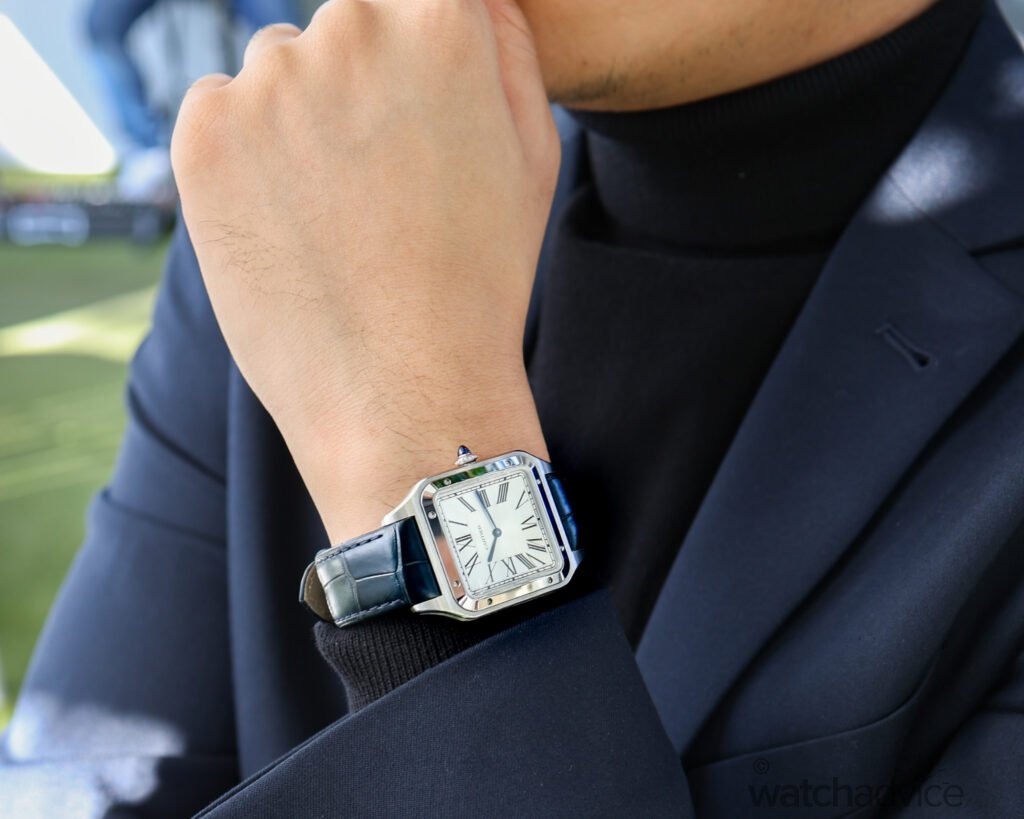
The Design
The Cartier Santos Dumont is both elegant, timeless and whilst minimalistic, still exudes little details. Others in Cartier’s lineup may have more intricate design elements, but this modern rendition of the OG demonstrates the fine art of subtraction. ‘Less is more’ with the Santos Dumont, leaning towards a dressier aesthetic whilst retaining the versatility and legibility intended for its original wearer.
The square dial, featuring a silver sunray brushing with a subtle champagne undertone, has several design features that are indicative of a Cartier timepiece. First are the radially printed Roman Numerals and railway minutes track, elegantly filling the dial with its timelessly Art Deco aesthetic. Something I’ve always loved about Cartier is their attention to detail, and the Santos Dumont, as minimalist as it is, maintains the secret Cartier signature in the VII (7) o’clock index.
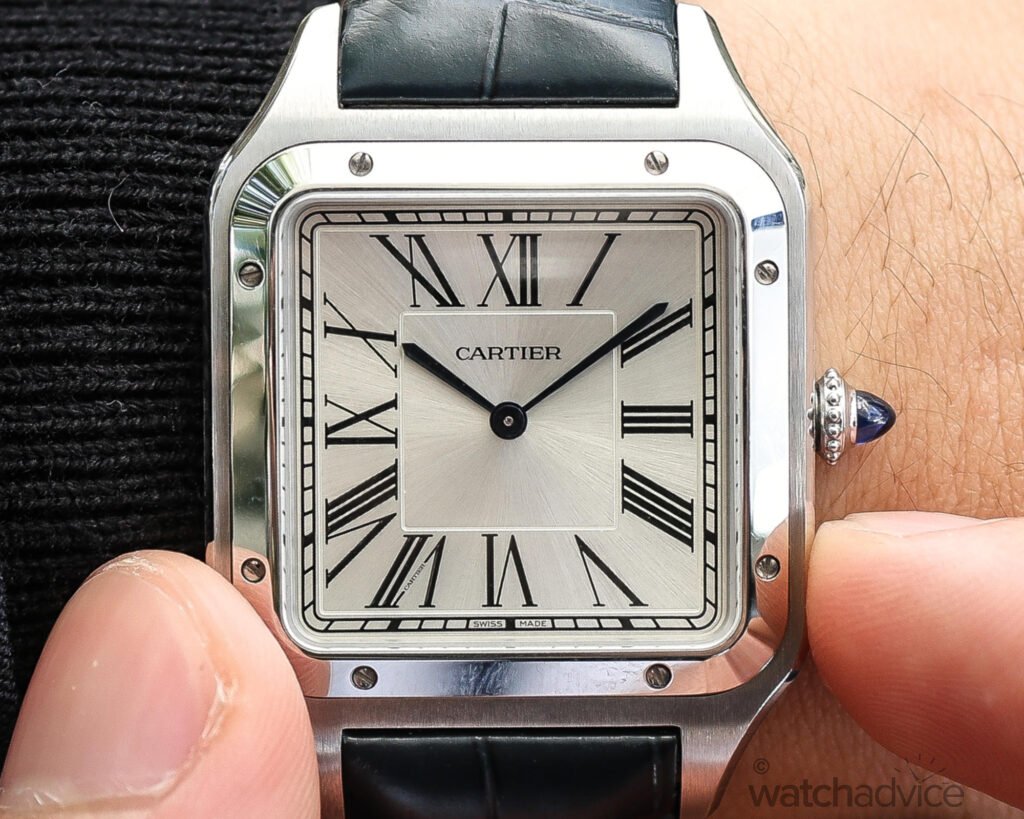
One thing I always notice on Roman dial watches is the inexplicable absence of “IV” – the Roman Numeral for four – and its replacement, “IIII”. This “IIII” has always been referred to as “the watchmaker’s four” and is used ubiquitously throughout the industry. However, its origins remain unknown. Some say it was the Ancient Romans, after realising the Latin term for Jupiter (IVPITER) also began with “IV,” and thus started using “IIII” to not upset the King of the Gods. Others say it was because of King Louis XIV, who wanted people to avoid using part of his title on clock dials in the 17th and 18th Century. But for me, I think that “IIII,” regardless of origin, adds both symmetry and legibility to all watches with Roman Numerals.
A subtly engraved square frame divides the numerals and minute track from the centre of the dial, where the printed Cartier logo and the Santos Dumont’s blued steel sword hands can be found. Two things worth noting here: While this modern rendition is predominantly true-to-life of the original, the iconic apple hands are not present. However, the sword hands have been a staple of Cartier’s timepieces since the 1980s, so the change is historically and aesthetically inconsequential.
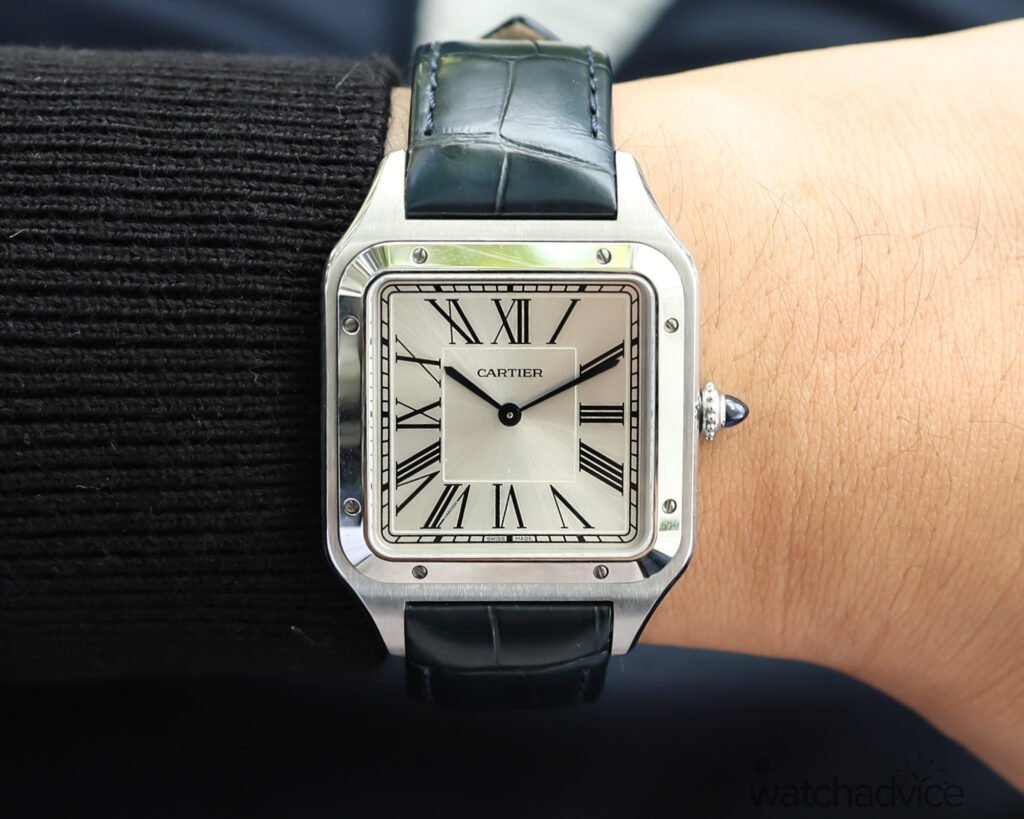
The other notable absence is that of the seconds hand, which is similarly justifiable due to the watch’s dressier nature. Let’s face it – if you’re wearing the Santos Dumont around to social events, you’re probably too engaged in meeting and talking to people to worry about counting the seconds. I’m glad the movement has a slightly lower beat rate to reflect this, as a higher beat rate would over-engineer an already refined piece (more on that later).
Moving on, the polished bezel with exposed screws, vertically brushed case exterior, and polished chamfering across the top and bottom serve to enhance the sophisticated look of the Santos Dumont. Yet another small detail is how the square case curves when you look at it from down the barrel, something I’ll touch on later in the article. Too often square and rectangular watches feel unwieldy on the hand and on the wrist, but the Santos Dumont’s curvature, echoed by the curved bezel and sapphire crystal, helps to remedy that issue.
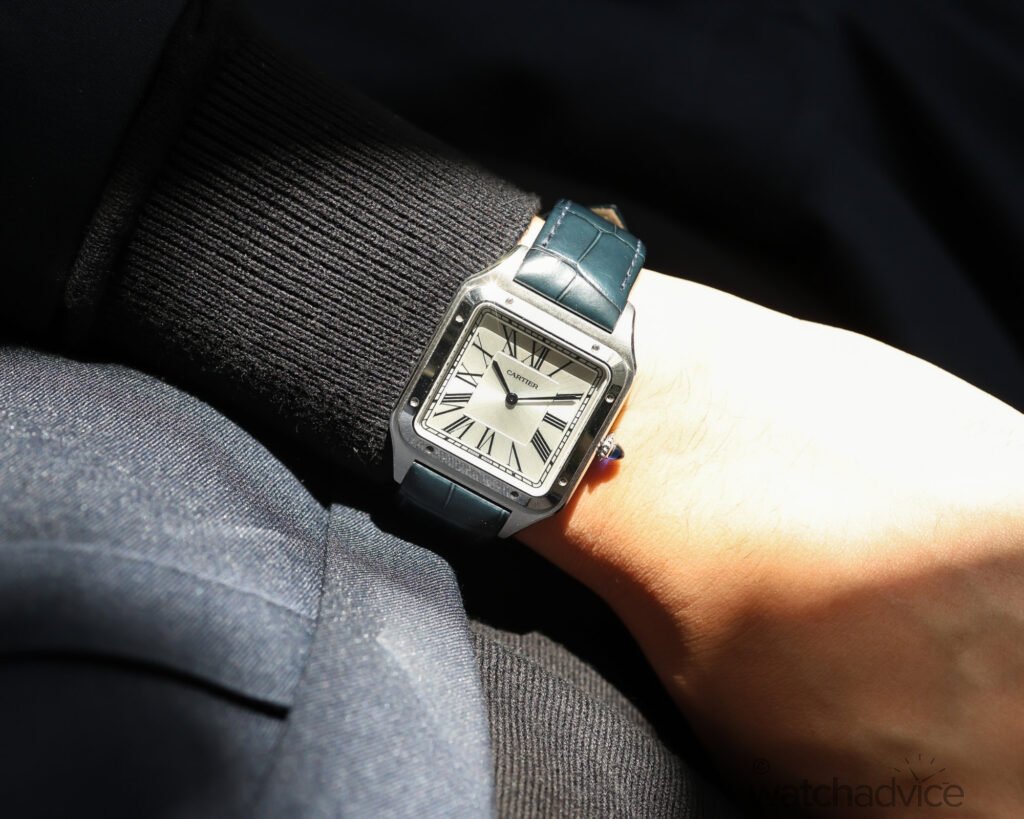
The blue spinel crown is, as with most Cartier models, present on this Santos Dumont. Other modern Cartiers, such as the new Santos De Cartier that we reviewed in June, have a more geometric and contemporary heptagonal design. Instead, the Santos Dumont hearkens back to the vintage styling, with a rounded cabochon and a beaded crown also present on some Tank models.
Lastly, the case back is also vertically brushed, revealing the other side of the exposed screws as well as the relevant Cartier specifications. This also includes a heartfelt tribute to the titular daredevil pilot who inspired the creation of the watch, with his signature engraved into the back of all Santos Dumont models.
How it Wears
At 33.9mm diameter, 46.6mm lug-to-lug, and 7.5mm thick, this Cartier Santos Dumont is what they call “Extra-Large.” From wearing the piece around, this is half true, but not in the way you would expect. As previously mentioned, most square watches have a tendency to wear a lot larger than their on-paper dimensions suggest. The Santos Dumont is no different, but thanks to the thinness and curvature of the case, it wore more comfortably than other square watches I’ve tried in the past. Something you’ll also notice is the extreme curvature of the lugs, which further enhance the wearability of the piece by having it wrap around the wrist of any who chooses to wear it.
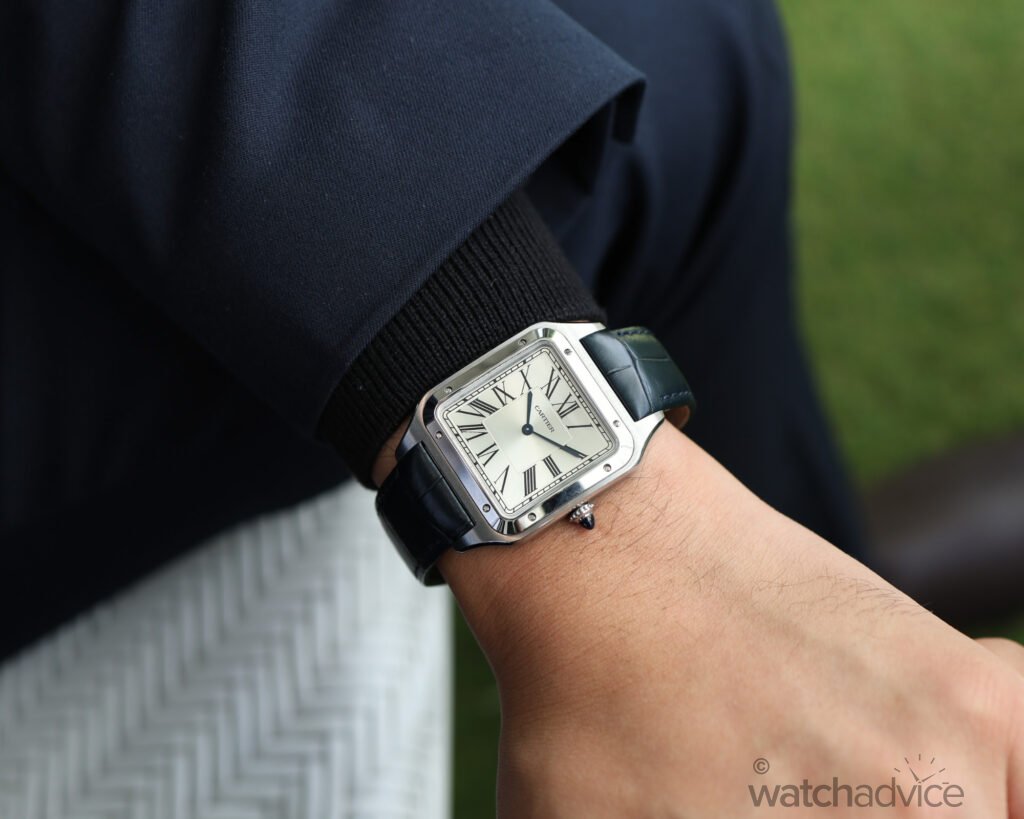
My wrist is about 16cm/6,3in, which admittedly is on the smaller side than average, and I would say the best point of comparison for those unfamiliar with the square watch experience is that the Santos Dumont is equivalent to about a 39mm to 40mm round timepiece – perfect for unisex wear. With just 30m water resistance, the watch is practical enough for everyday and formal wear, but one that you obviously wouldn’t wear in harsher conditions. For that job, perhaps turn to some of their more robust models, like the Pasha or the Santos De Cartier.
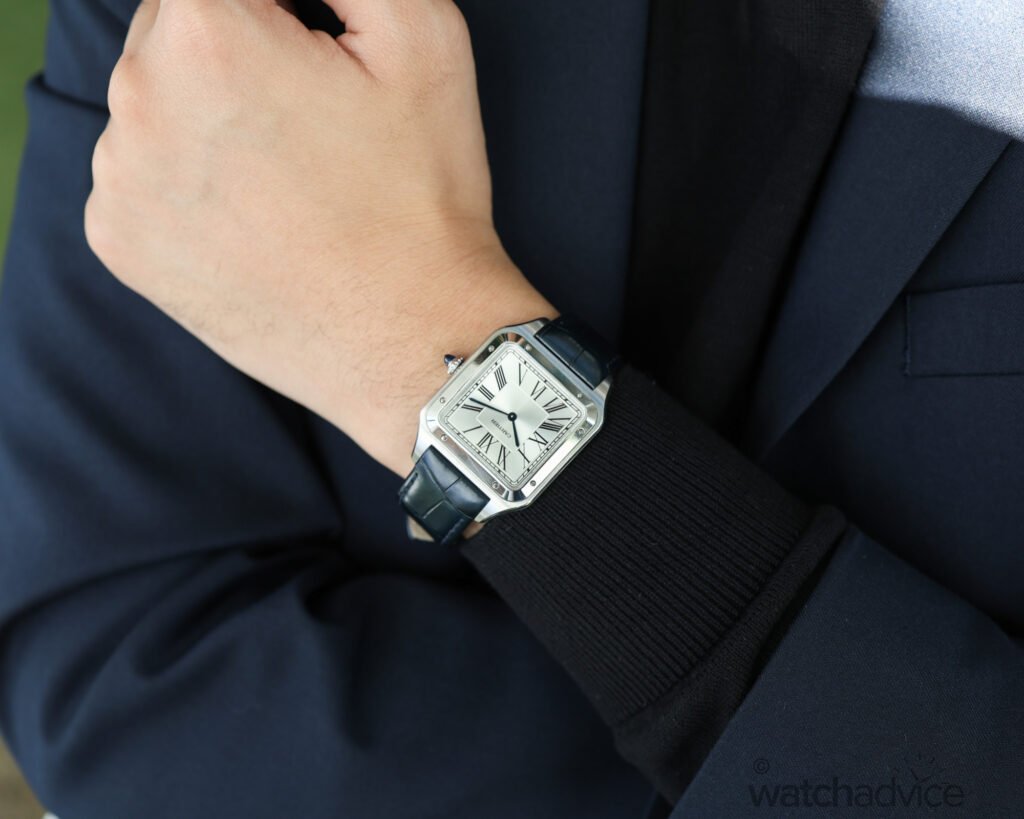
However, that doesn’t mean the wearability is perfect as is. While Cartier has done much to mitigate the wearing experience, it is called “Extra-Large” for a reason. In a similar vein to integrated bracelet timepieces, the strap tends to flare out from the case, adding several millimetres to the lug-to-lug and making the leather strap larger than anticipated. Even on the smallest adjustment hole, I found that the Santos Dumont, though thin and comfortable, was on the edge of what my wrist could tolerate. Again, one of the problems I do have with being more slight of wrist. However, if you have a medium/average sized wrist around 17cm or more, then this won’t be an issue for you at all and will fit perfectly. Matt in the team tried this piece on and with 17.5cm wrists, he comfortably pulls this off. For reference, read his review on the Santos de Cartier here to see how a similar designed piece, but larger wears on his wrist.
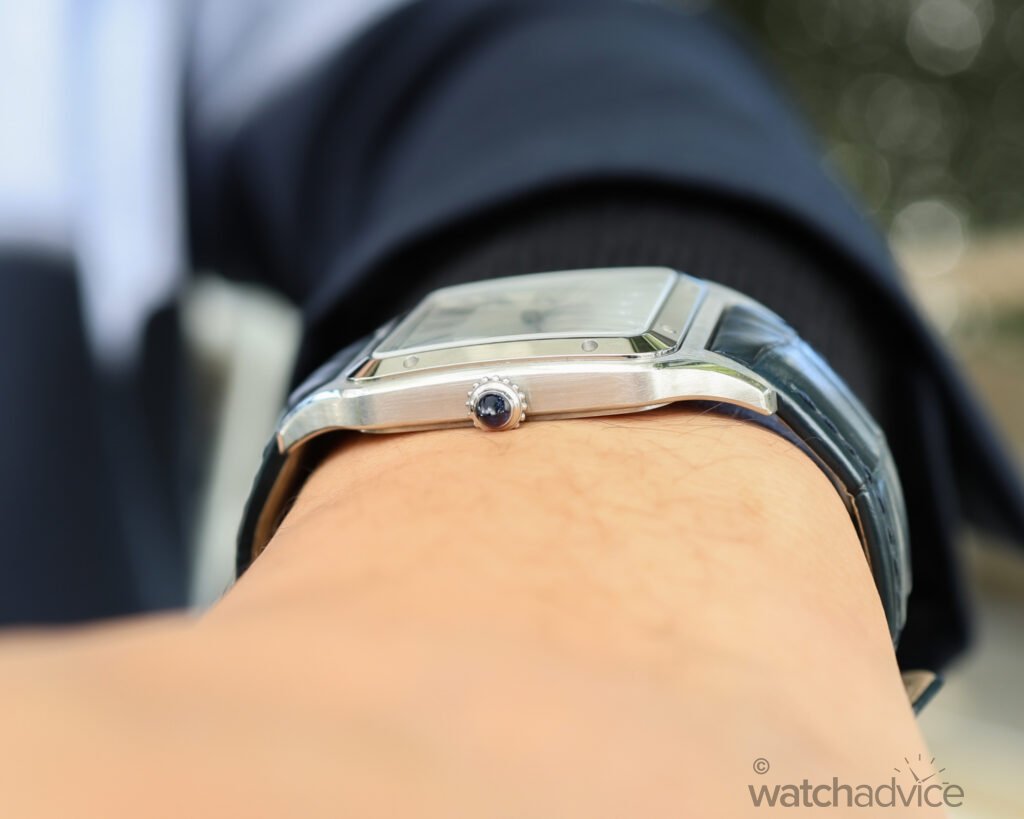
Thankfully, if you are in need of a smaller strap, Cartier has made accommodations for you to do so. Though you wouldn’t find it on many dress pieces these days, Cartier has included quick-release features on the original alligator leather strap, coloured in a dark navy blue. This is a feature that is also present on many other Cartier models. Personally, I think the navy blue suits the watch perfectly – although a smaller one would be nice – but the inclusion of quick-release straps means that Cartier has opened the floor for you to personalise to your heart’s content. The only limits, of course, are your imagination, your budget, and your personal preferences.

My only real point of contention is the buckle. I love an elegantly designed buckle as much as the next watch enthusiast, but I found that the pin was thin and a little tricky to use. This could perhaps be more an issue with my smaller wrist size getting the strap done up and undone than a major design floor. Something you would need to consider and look at should you be in the market to purchase. However in saying this, the buckle suits the piece and compliments the Santos Dumont nicely.
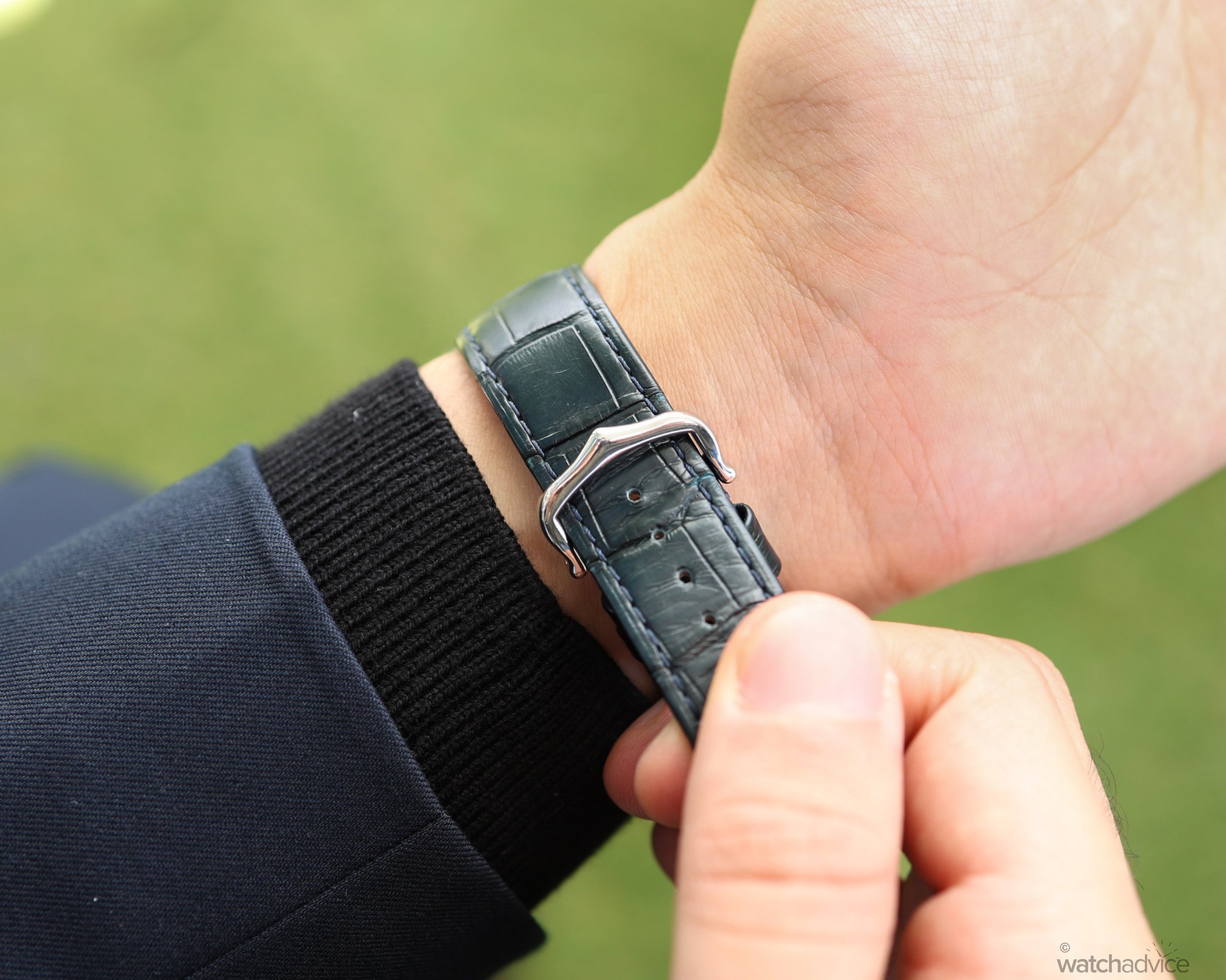
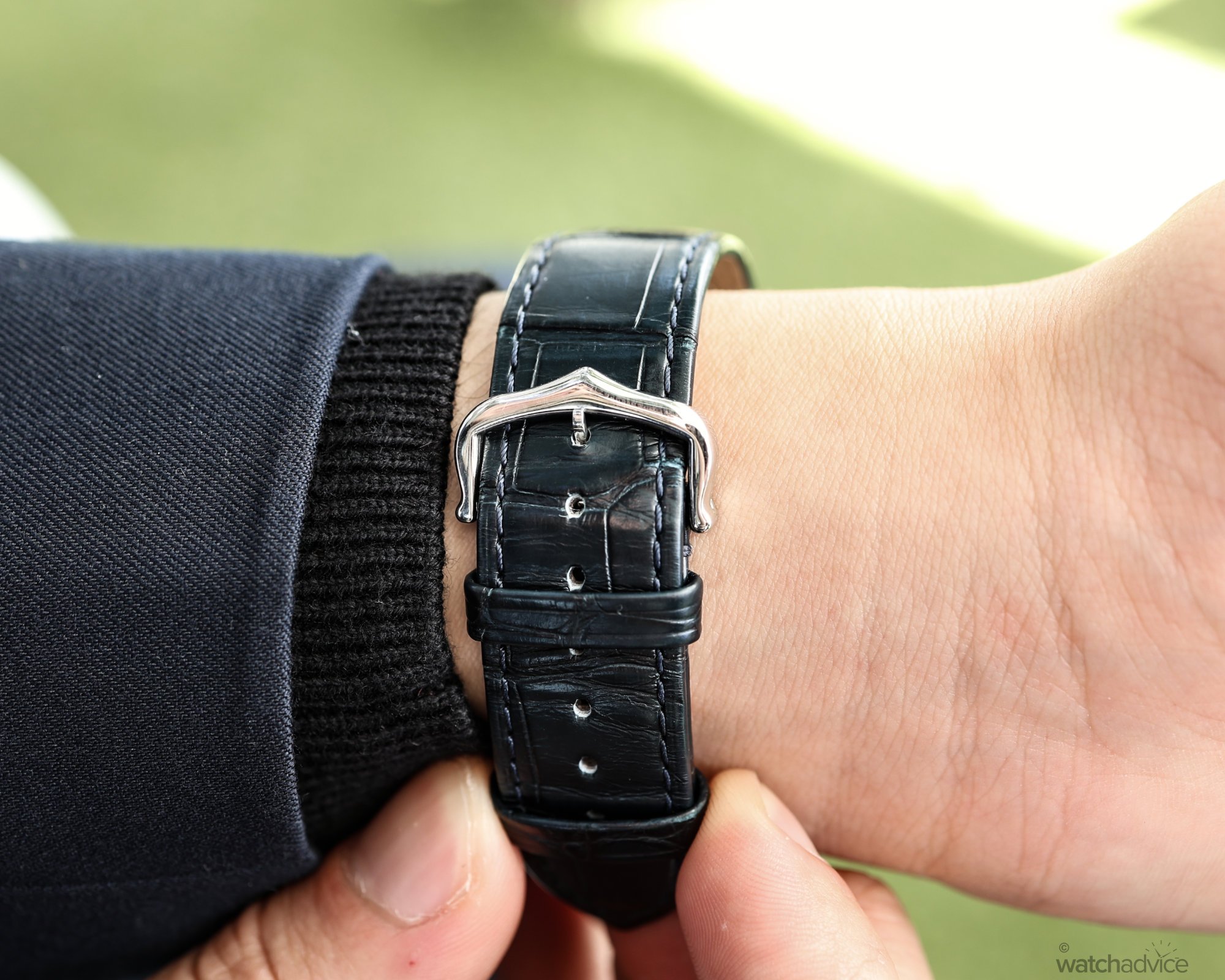
The Movement
The Cartier Santos Dumont features the manual wind 430 MC movement, which beats at 3Hz (21,600vph) backed by 43 hours of power reserve. As I said before, the lower beat rate is welcome on a dress watch without a second hand, as is the slim and low-profile nature of the movement that contributes majorly to the thinness of the watch. An automatic movement like the 1847 MC, while not unwelcome, would not make as much sense here. It would throw the wearing experience completely out of balance, and a Santos Dumont, at least in my opinion was never destined for wearing all the time. A manual wind movement is perfectly in line with those times when you need to add a touch of refinement to your style.
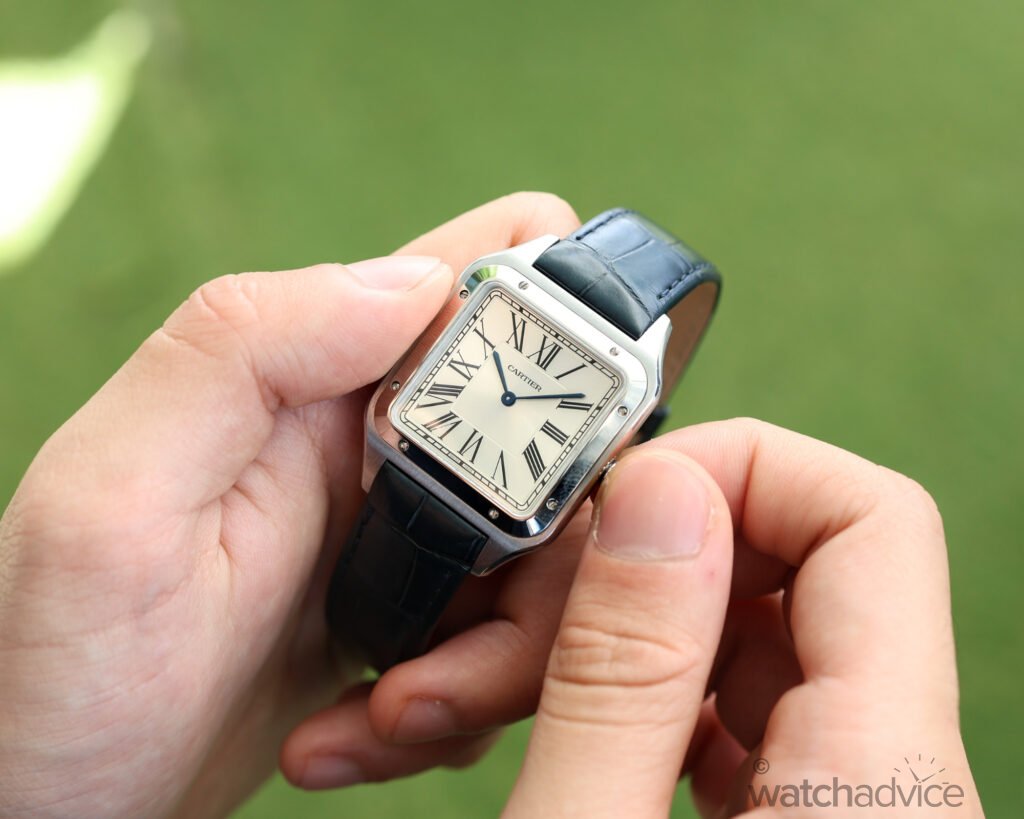
While I do appreciate the implementation of the 430 MC, it does sadden me a little that the watch doesn’t include a display case back. Totally justifiable as to why – it’s close to the original, and allows for the tribute to Alberto Santos-Dumont with his engraved signature on the caseback. I also say it for this reason – the Santos Dumont does have a smaller quartz counterpart, and it would have been nice to be able to not only differentiate the two but to also assure myself that the watch is functioning by examining the escapement instead of holding it up to my ear and listening really hard.
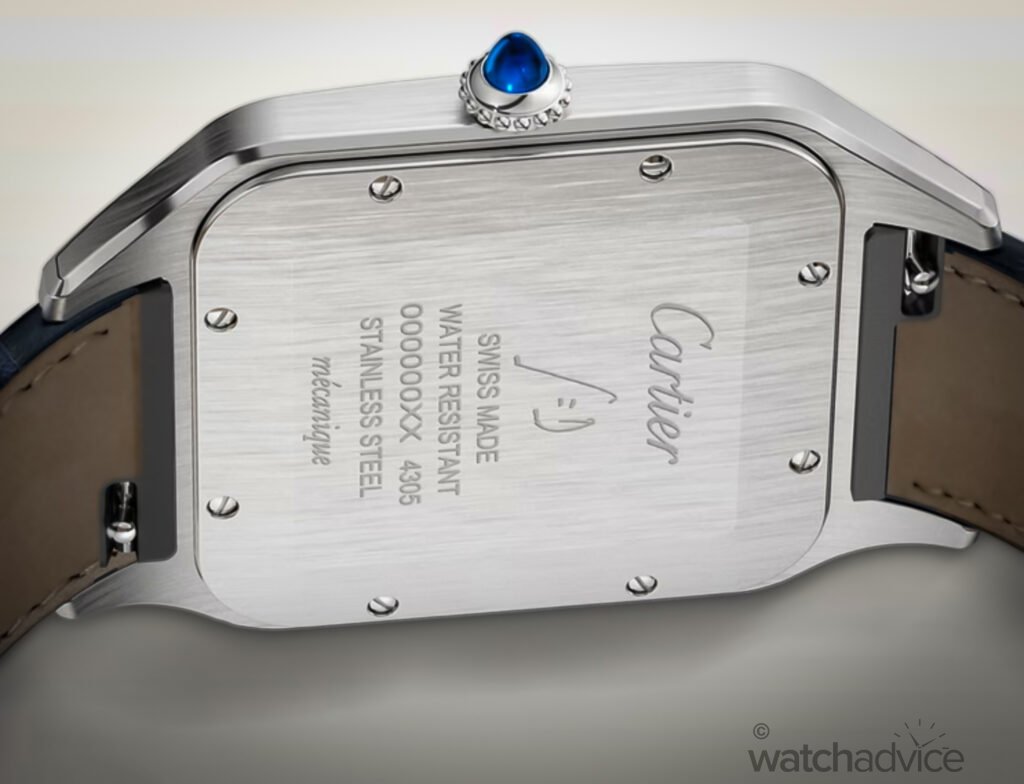
One noteworthy aspect of owning a Santos Dumont is Cartier Care, which allows the owner of any Cartier timepiece to register their watch and extend their international warranty from two to a staggering eight years, including a range of complementary services. Experience with such services varies by retailer, of course, but the bottom line is that eight years is an astonishing amount of time to grant for warranty on a timepiece. Beating the luxury industry standard by three years is something worth taking seriously, and shows that Cartier is both committed to the enthusiast’s peace of mind and deadly confident about their calibre of watchmaking.
RELATED READING: How Cartier Creates Its Iconic Pieces
Final Thoughts
It can’t be denied that the Cartier Santos Dumont certainly lies in an interesting price point, and the dangers of competition at AU$10K-AU$13K are certainly present. The Omega De Ville Trésor (AU$11,750) and the IWC Portugieser Automatic 40 (AU$11,400) immediately come to mind when it comes to contenders in this price point, however, both don’t have the square cases shape and look of the Santos Dumont. Strangely enough, the strongest contender is from Cartier itself: the Medium Santos de Cartier, priced at AU$11,500. Which if you ask me, isn’t a bad thing if you’re wanting a nice dressier piece in a square shape.
While the Santos Dumont certainly dominates in terms of its elegance and aesthetics, the Santos de Cartier comes outfitted with an automatic movement, 100m water resistance, and a quick-change/quick-adjust steel strap that makes it (at least on paper) a potentially better value proposition when compared to the Santos Dumont. As with any watch purchase, though, there are no right or wrong answers here. It’s about individual tastes and style, something Cartier knows all too well and caters for. The Santos Dumont remains an icon of the watch industry, but it can be difficult to convince the first-time buyer to deviate from what is one of the most dominant and versatile timepieces of modern horology. In saying this, the Santos Dumont is most probably a piece that you add to your collection, and not start with, so it has its place in any collection and on the wrist.
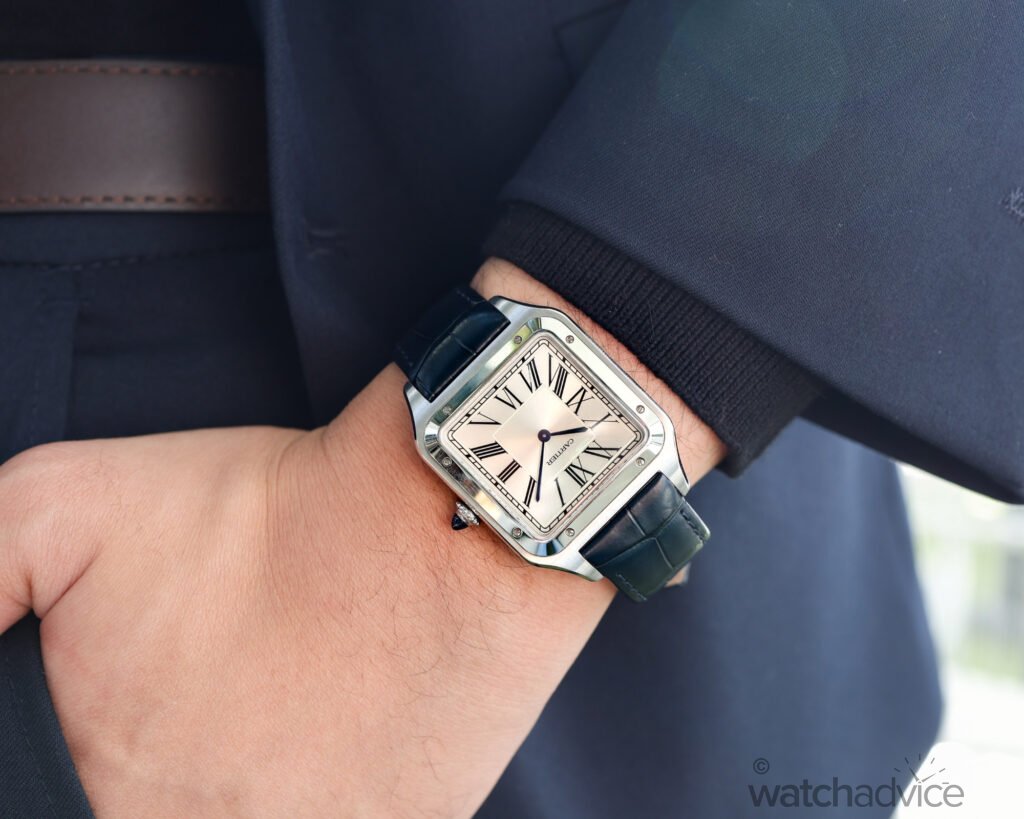
The Cartier Santos Dumont may be minimalist in appearance (on the surface), but it maximises its overall potential in heritage, aesthetics, and fine craftsmanship – again, its the little details that count. Every element, facet, surface, and texture is precisely where it needs to be. It’s like wearing a Michelin-star dish on your wrist—a masterful example of excellence achieved through exercising complete control over the fundamentals of watch design. The case is elegantly thought-out, the movement is slim and appropriate for the attitude this watch carries, and the leather strap – although large (for me) and sometimes fiddly – matches the dynamic of the watch perfectly.
If I’m being honest, the first time I ever walked into a Cartier boutique, I only knew about the Tank. Now, having experienced both a Santos de Cartier and a Santos Dumont, I have to say that the Santos Dumont may actually be the one that has won me over in the end. Yes, technically the Santos de Cartier offers more contemporary appeal for the modern enthusiast. However, the Santos Dumont has one thing that the rest of its peers lack: A deep heritage and Aura.
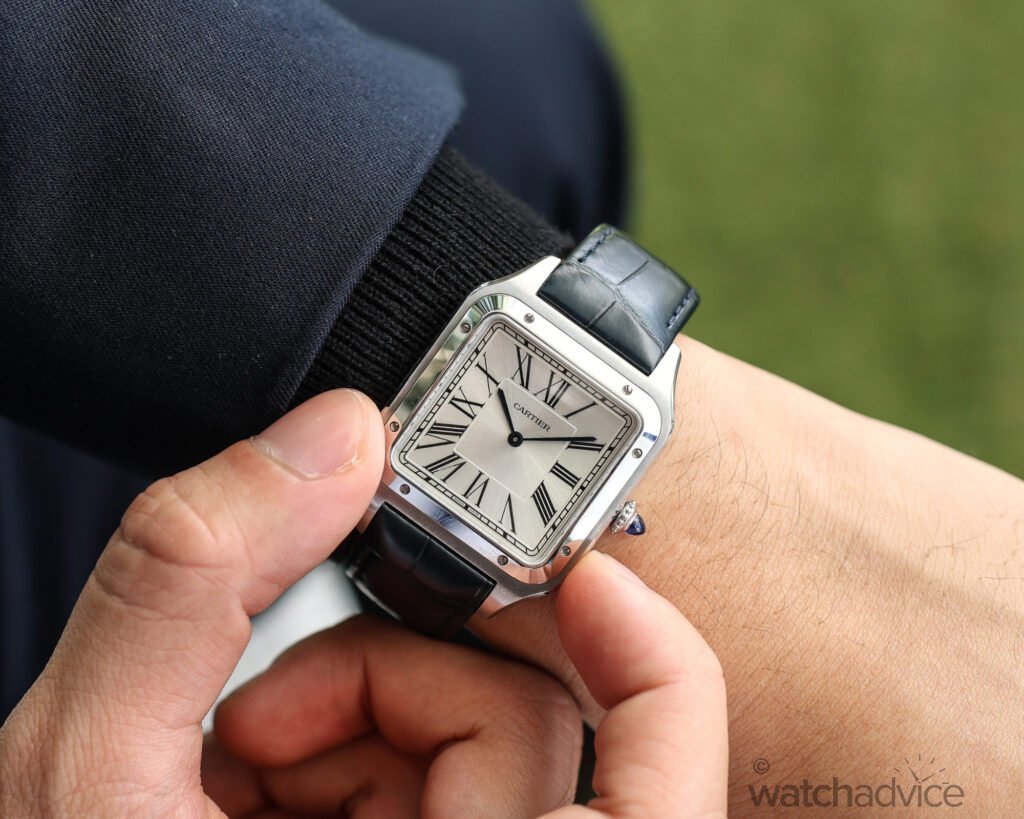
There are some watches you come across in life that just have that certain ‘it’ factor. These chosen few pieces have a presence like no other, drawing everyone in like it’s The One Ring. One cannot simply describe what that factor is. Perhaps it has to do with the delicately executed aesthetics. Maybe it’s the slim and comfortable wearing experience. Or maybe, it’s the knowledge that generations’ worth of horological heritage is packaged tightly and succinctly into one watch!
Reference: WSSA0032
Specifications
- Case: 33.9mm case diameter x 46.6mm lug-to-lug x 7.5mm thickness
- Case Material: Stainless steel
- Dial: Silver
- Water resistance: 30m (3 Bar)
- Movement: Manual Wind Cal. 430 MC movement
- Movement Frequency: 3Hz (21,600 VpH)
- Power reserve: 43 hours
- Bracelet: Quick-change alligator leather with steel pin buckle
Australian Recommended Retail Price: AU$10,200
Availability: Available now, from Cartier.com.au or any Authorised Cartier Retailers
Image Gallery
